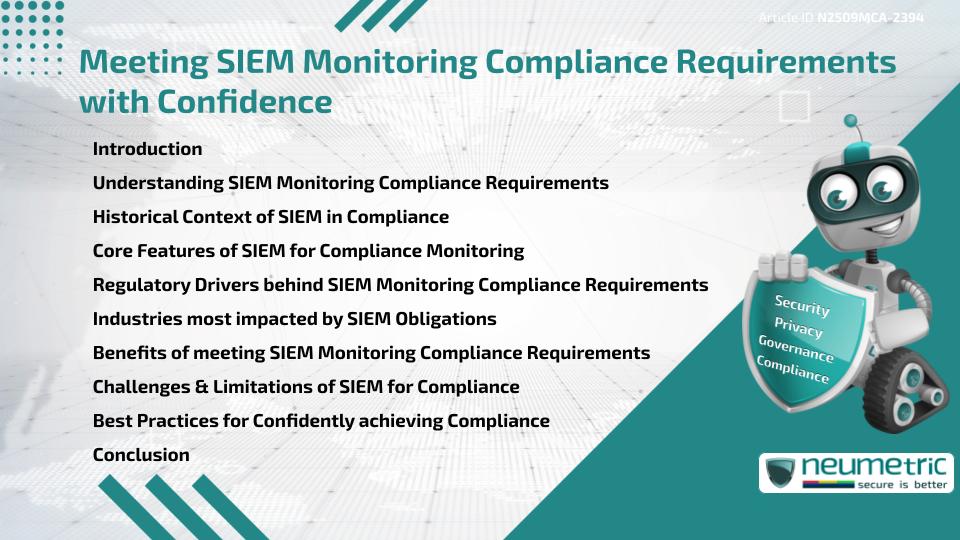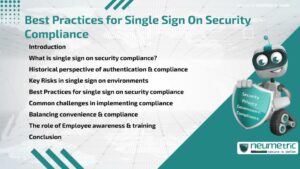Table of Contents
ToggleIntroduction
SIEM Monitoring Compliance Requirements have become a cornerstone of modern Cybersecurity Programs. Security Information & Event Management [SIEM] Systems provide centralised visibility into Logs, Events & Alerts, enabling Organisations to detect Threats & meet Regulatory Standards. From PCI DSS to HIPAA & GDPR, many frameworks require Continuous Monitoring, making SIEM indispensable for Compliance. This article examines the role of SIEM in Compliance, its historical development, regulatory drivers, benefits, limitations & best practices to help Organisations meet requirements with confidence.
Understanding SIEM Monitoring Compliance Requirements
SIEM Monitoring Compliance Requirements define how Organisations must collect, analyse & retain Log data to demonstrate Security oversight. SIEM Tools consolidate Logs from Networks, Applications & Endpoints, allowing Compliance teams to monitor Access, detect Anomalies & produce Reports for Audits. These requirements ensure that Security Operations align with Regulations & Industry Standards.
Historical Context of SIEM in Compliance
SIEM technoLogy emerged in the early 2000s as Organisations struggled to manage increasing Log data. Initially designed for Threat detection, SIEM quickly became tied to Compliance obligations, particularly with the introduction of PCI DSS in 2004. Over time, SIEM tools evolved to support Data Retention, Reporting Templates & Automated Compliance Evidence generation. Today, SIEM is a fundamental part of Compliance-driven Security Monitoring.
Core Features of SIEM for Compliance Monitoring
Organisations rely on SIEM Systems to meet Compliance by offering:
- Centralised Log collection & normalisation
- Correlation Rules for detecting suspicious activities
- Automated alerts & Reporting features
- Long-term Log storage for Regulatory Retention requirements
- Dashboards tailored for Compliance Audits
- Integration with Incident Response Processes
These features streamline Compliance while enhancing Security Posture.
Regulatory Drivers behind SIEM Monitoring Compliance Requirements
Several Regulations & Standards require or strongly recommend SIEM use:
- PCI DSS: Requires Log Monitoring of Cardholder Environments.
- HIPAA: Mandates tracking of access to protected Health Information.
- GDPR: Demands Security Monitoring to protect Personal Data.
- ISO 27001: Emphasises event Logging & Monitoring for Risk Management.
- NIST Guidance: Provides detailed Controls for Continuous Monitoring.
These drivers highlight SIEM’s central role in Compliance Frameworks.
Industries most impacted by SIEM Obligations
Industries handling Sensitive Data are most affected by SIEM Monitoring Compliance Requirements:
- Financial Services: Must comply with PCI DSS, SOX & Regional Banking rules.
- Healthcare: Governed by HIPAA & other Privacy Laws.
- Retail & E-Commerce: Focused on Payment Data Protection.
- Government & Defense: Required to follow NIST & other Federal guidelines.
- TechnoLogy & SaaS Providers: Expected to prove Monitoring capabilities to Customers.
In each Sector, SIEM helps Organisations balance Compliance with Operational needs.
Benefits of meeting SIEM Monitoring Compliance Requirements
Adopting SIEM to meet Compliance obligations delivers significant advantages:
- Real-time Threat detection & Response capabilities
- Simplified Audit preparation through automated Reports
- Stronger protection against Insider Threats & Unauthorised Access
- Improved Customer Trust & Business Reputation
- Reduced Risk of Regulatory Fines & Penalties
SIEM makes Compliance a driver of both Operational efficiency & Customer assurance.
Challenges & Limitations of SIEM for Compliance
Despite its advantages, Organisations face hurdles in meeting SIEM Monitoring Compliance Requirements:
- High costs of purchasing & maintaining SIEM Platforms
- Complexity in Configuration & Rule tuning
- Risk of Alert fatigue from excessive False positives
- Skilled Personnel requirements for effective use
- Potential Gaps in coverage if Logs are not fully integrated
Recognising these challenges is key to realistic Planning & Resource allocation.
Best Practices for Confidently achieving Compliance
To meet SIEM Monitoring Compliance Requirements effectively, Organisations should:
- Define clear Compliance objectives & align SIEM rules accordingly
- Regularly review & Fine-tune correlation rules
- Automate Evidence collection & Audit reporting
- Ensure Log coverage across all Critical Assets & Applications
- Train Security Staff to interpret Alerts & manage Compliance tasks
- Periodically assess SIEM effectiveness against Compliance standards
These practices transform SIEM from a Compliance checkbox into a valuable Security Asset.
Conclusion
SIEM Monitoring Compliance Requirements are no longer optional-they are essential for Organisations seeking to secure Sensitive Data & prove Regulatory alignment. By understanding Regulatory drivers, leveraging SIEM features & applying Best Practices, Organisations can approach Compliance with confidence while strengthening their overall Security resilience.
Takeaways
- SIEM Monitoring Compliance Requirements ensure oversight of Logs, Events & Anomalies
- Historical roots link SIEM adoption with PCI DSS & other Frameworks
- Core features include centralised Logs, Correlation rules & Reporting
- Regulations like PCI DSS, HIPAA, GDPR & ISO 27001 drive SIEM adoption
- Industries most affected include Finance, Healthcare, Retail & Government
- Benefits include real-time Detection, simplified Audits & improved Trust
- Challenges include high Costs, Alert fatigue & Skill shortages
- Best Practices involve Automation, Fine-tuning & Staff training
FAQ
What are SIEM Monitoring Compliance Requirements?
They are obligations to collect, analyse & retain Log data using SIEM Systems to meet Regulatory Standards.
Which Regulations require SIEM Monitoring?
PCI DSS, HIPAA, GDPR, ISO 27001 & NIST guidance emphasise Monitoring & Logging requirements.
Why is SIEM important for Compliance?
It centralises Log Data, supports Audits & provides real-time Security Monitoring required by Regulations.
How do SIEM tools simplify Audits?
They automate Log collection, generate Compliance Reports & maintain Evidence for Auditors.
Are SIEM Systems expensive to implement?
Yes, SIEM Platforms can be costly, but they provide long-term savings by reducing Fines & improving Security.
Can Small Businesses meet SIEM Monitoring Compliance Requirements?
Yes, Smaller Businesses may adopt Cloud-based or Managed SIEM solutions to reduce cost & complexity.
What challenges come with SIEM implementation?
Challenges include high Costs, Technical complexity, False positives & the need for skilled Staff.
Need help for Security, Privacy, Governance & VAPT?
Neumetric provides organisations the necessary help to achieve their Cybersecurity, Compliance, Governance, Privacy, Certifications & Pentesting needs.
Organisations & Businesses, specifically those which provide SaaS & AI Solutions in the Fintech, BFSI & other regulated sectors, usually need a Cybersecurity Partner for meeting & maintaining the ongoing Security & Privacy needs & requirements of their Enterprise Clients & Privacy conscious Customers.
SOC 2, ISO 27001, ISO 42001, NIST, HIPAA, HECVAT, EU GDPR are some of the Frameworks that are served by Fusion – a SaaS, multimodular, multitenant, centralised, automated, Cybersecurity & Compliance Management system.
Neumetric also provides Expert Services for technical security which covers VAPT for Web Applications, APIs, iOS & Android Mobile Apps, Security Testing for AWS & other Cloud Environments & Cloud Infrastructure & other similar scopes.
Reach out to us by Email or filling out the Contact Form…





